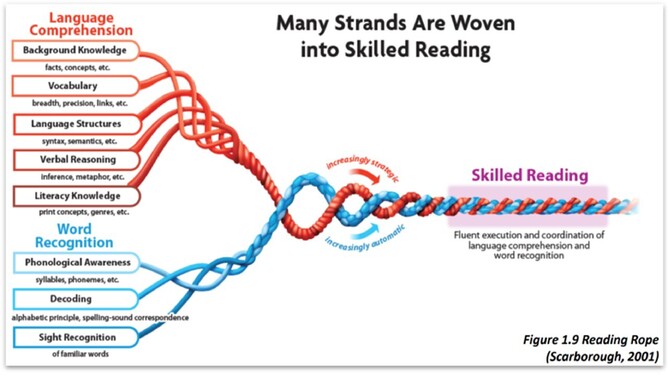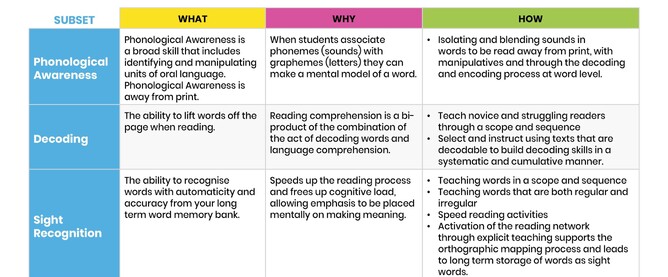Teaching reading as Dr Louisa Moats would say really is ‘Rocket Science’. There is so much to learn with regards to what must be taught and the importance of explicit teaching throughout the teaching process.
I still often find myself saying, “I wish I knew then what I know now”. I, like many of you, have become a lot more accepting of the lack of knowledge and practice I had when I was a qualified classroom teacher and school principal, but I was untrained in how our brains learn to read, and ultimately how ALL brains should be taught.
So, what does quality instruction look like? What do we as teachers need to know and how do we plan for this?
In this blog I have set out to assist those of you with children who are dyslexic. You may be a classroom teacher or a parent at home. I hope this helps you to further understand or review the components we must include, and I will also provide a lesson structure for you to follow with all the necessary components present. I also hope this information will help your understanding of the importance of explicitly teaching into a text and that you don’t only teach this way when using a decodable text.
The International Dyslexia Association states:
The most difficult problem for students with dyslexia is learning to read. Unfortunately, popularly employed reading approaches, such as Guided Reading or Balanced Literacy, are not effective for struggling readers. These approaches are especially ineffective for students with dyslexia because they do not focus on the decoding skills these students need to succeed in reading.
What does work is Structured Literacy, which prepares students to decode words in an explicit and systematic manner. This approach not only helps students with dyslexia, but there is substantial evidence that it is more effective for all readers. What impact will these standards have on my child with dyslexia or other disabilities if he or she cannot read or write at the expected level? (1)
What we want for our students is to be able to lift words off the page (using their word recognition skills and/or store of orthographically mapped words in their long-term memory) as well as for them to make meaning. A Structured Literacy approach in my opinion and experience does this so much more sequentially and explicitly than other approaches such as balanced literacy, phonics in isolation and whole language.
Scarborough’s (2001) Reading Rope is a really important place to start to build our knowledge and to ensure our reading instruction is evidence-based. This also acts as a good mechanism to dispel any myths about Structured Literacy being purely about phonics, spelling and/or the decoding process alone. Structured Literacy is so much more than that. When we teach Structured Literacy with integrity and fidelity, we teach all strands of the rope systematically and explicitly. To do so though we need to understand the subsets of the Language Comprehension strands and Word Recognition strands.
The WHAT, WHY and HOW of teaching the subsets of Language Comprehension:
It is important to understand that meaning does not automatically follow the successful decoding of a word. If the word/s students are reading are not part of their word lexicon - they will struggle to understand or apply this word to print for reading comprehension. Reading vocabulary is crucial to the comprehension processes of a skilled reader.
The WHAT, WHY and HOW of teaching the subsets Word Recognition:
So, what do we do with this knowledge? Knowledge alone isn’t enough. Execution is what ultimately MATTERS right?
I cannot stress enough, that teaching explicitly is key. To teach explicitly means to execute or teach concepts clearly and in a way that students get it. The teaching of vocabulary is a good example here. Too often we rely on questioning techniques such as “who knows the meaning of squirmy?” We’ve all done it. But now is not the time for a formative assessment piece in our lessons. We all have limited time so let’s be sure to use our teaching time efficiently. Rabbit holes are everywhere!! So often students go off on a tangent and don't have the vocabulary to explain explicitly a key vocab word or piece of content. This leads to wasted time and teachers having to backtrack and potentially correct misinformation.
Instead, it is crucial that teachers prepare well and appreciate that they are the experts. The use of questioning described above does not align with the explicit teaching principles. Tell, Tell, Tell and ask only when checking for understanding or providing opportunities for review and rehearsal of new knowledge you have explicitly fed in. When we know better, we certainly do better. To teach well we MUST have sound knowledge of and be skilled in explicit teaching.
As part of the iDeaL Approach to Structured Literacy, the team at learning MATTERS have developed lesson plans to ensure all students are taught in years 1-8 using a well-structured, comprehensive teaching plan that addresses all aspects of the reading rope. Feedback from teachers regarding these lesson plans has been really positive. In fact one school is really noticing shifts in their PAT reading comprehension data and early indicators would attribute this to the explicit teaching of Structured Literacy through the use of the iDeaL reading plans.
"What has been the most amazing news is the results and shifts children have made with their PAT reading comprehension, huge jumps in fact. This is only initial teacher info, and we will be analysing it more over the holidays, but the big shifts are being seen in the classes that have adopted the SL reading plan for authentic texts.”
Structured Literacy instructional reading plans must include explicit teaching of all aspects of the reading rope. These won’t necessarily all be taught in one lesson.
There are some key aspects that we recommend should be considered when constructing your reading plan:
- Using a structured plan that teaches across all or most of the Word Recognition and Language Comprehension subsets throughout a week
- Teaching into, and through one text per week (either decodable or authentic text)
- Placing previously read texts into a fluency box for repeated readings.
We have the Knowledge. We understand the importance of Execution. Now we need a structure to bring this all together.
Let’s have a look at an iDeaL reading plan to see what this looks like. You can see we have labelled the teaching plan and identified where the subsets of the Reading Rope are going to be explicitly taught.
This plan is a guideline. It serves to support teachers with Structured Literacy instruction with fidelity and as a mechanism to dispel myths that Structured Literacy is about teaching for the development of word recognition skills alone. The example plan is guided by research. When we execute this with explicit instruction, we are much more likely to ensure success for ALL.
When teaching reading using these plans, I have had so much success teaching students of all abilities (those with and without dyslexia).
Further plans are available via the iDeaL Approach to Structured Literacy. For the purpose of this blog, we have added an authentic text lesson plan example (as shown above) as a FREE download. We hope that this will assist both teachers and parents who are starting out on their journey of evidence-based reading instruction as well as those looking for a well-structured systematic lesson plan.
Go for the deep dive and do it well. Not only for our dyslexic tamariki but for ALL of them.
Carla McNeil
Carla is the Founder and Director of Learning MATTERS Ltd. Carla has been a successful School Principal, Mathematics Advisor and Classroom Teacher.












